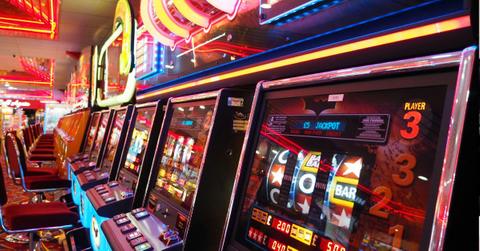 NEWS
NEWSHow to Spot the Difference Between a Tight and Loose Slot Machine

May 21 2025, Published 1:55 a.m. ET
Slot machines are one of the most popular casino games, offering players the thrill of spinning reels and chasing big wins. However, not all slot machines are created equal. Some are loose, meaning they pay out more frequently, while others are tight, meaning they hold onto players' money longer before awarding a win.
Understanding the difference between tight and loose slot machines can help players make smarter choices and improve their chances of winning. In this article, we’ll explore how to spot the difference between a tight and loose slot machine, what factors influence payouts, and how casinos set up their machines.
What Are Tight and Loose Slot Machines?
Loose Slot Machines
A loose slot machine is one that has a higher payout percentage, meaning it returns more money to players over time. These machines:
●Offer frequent small wins to keep players engaged.
●Have a higher Return to Player (RTP) percentage, usually above 96%.
●Are often placed in high-traffic areas to attract more players.
Loose slots are more rewarding for casual players who want to enjoy longer gaming sessions without losing money too quickly.
Tight Slot Machines
A tight slot machine has a lower payout percentage, meaning it holds onto players' money longer before awarding a win. These machines:
●Offer fewer wins, making it harder to recover losses.
●Have a lower RTP percentage, usually below 94%.
●Are often placed in less visible areas of the casino.
Tight slots are riskier, as they require more spins before hitting a payout. Players should be cautious when playing these machines.
How Casinos Set Up Slot Machines
Casino Floor Placement
Casinos strategically place loose slot machines in areas where they attract attention. These locations include:
●Near entrances to draw players in.
●Close to high-traffic walkways where people pass by frequently.
●Near table games to encourage crossover play.
On the other hand, tight slot machines are often placed in:
●Corners or isolated areas where fewer people play.
●Near cash-out stations, where players may spend leftover money.
●Next to high-paying machines, making them seem more rewarding.
Understanding casino floor placement can help players find better-paying machines.
Return to Player (RTP) Percentage
Every slot machine has an RTP percentage, which represents the amount of money it returns to players over time.
●Loose slots have an RTP of 96% or higher, meaning they pay back $96 for every $100 wagered.
●Tight slots have an RTP of 94% or lower, meaning they pay back less money over time.
Checking the RTP percentage before playing can help players choose better machines.
How to Spot a Loose Slot Machine
Look for High RTP Games
Before playing, check the game’s RTP percentage. Many online casinos display RTP rates in the game’s information section.
●Choose games with 96% or higher RTP for better payouts.
●Avoid games with low RTP, as they are more likely to be tight.
Observe Player Activity
Loose slot machines tend to attract more players because they offer frequent wins. If you see a machine with:
●Many people playing for long periods, it may be loose.
●Players celebrating wins, it’s likely paying out frequently.
Watching how others interact with a machine can give clues about its payout behavior.
Check the Casino’s Layout
Casinos place loose slots in high-traffic areas to encourage play. Look for machines near:
●Entrances and walkways.
●Popular table games.
●Food courts or entertainment areas.
Avoid machines in isolated corners, as they are more likely to be tight.
Want OK! each day? Sign up here!
How to Avoid Tight Slot Machines
Stay Away from Low RTP Games
If a slot machine has an RTP below 94%, it’s considered tight. Avoid these games, as they hold onto money longer before paying out.
Avoid Machines Near Cash-Out Stations
Casinos place tight slots near cash-out stations to encourage players to spend leftover money. These machines are designed to take more than they give, making them risky choices.
Watch for Machines That Rarely Pay Out
If a machine hasn’t paid out in a long time, it may be tight. Signs of a tight slot include:
●Players leaving quickly after losing money.
●No visible wins over multiple spins.
●Low player engagement.
Choosing machines with frequent payouts increases the chances of winning.
Tips for Playing Slot Machines Wisely
Set a Budget and Stick to It
Before playing, decide how much money you’re willing to spend.
●Never chase losses, as slot machines are random.
●Set a win/loss limit to avoid overspending.
●Cash out winnings instead of reinvesting them.
Play Games with Bonus Features
Slot machines with bonus rounds, free spins, and multipliers offer better chances of winning.
●Look for games with progressive jackpots for big payouts.
●Choose slots with multiple paylines to increase winning opportunities.
Take Advantage of Casino Promotions
Many casinos offer free spins, deposit bonuses, and cashback rewards.
●Use welcome bonuses to play without risking money.
●Join loyalty programs for extra perks.
Taking advantage of promotions can extend playtime and improve winnings.
Conclusion
Understanding the difference between tight and loose slot machines can help players make smarter gambling decisions. Loose slots offer higher payouts and frequent wins, while tight slots hold onto money longer before paying out.
By checking RTP percentages, observing player activity, and understanding casino floor placement, players can spot better-paying machines and avoid risky ones.
While slot machines are random, choosing the right games and playing responsibly can increase enjoyment and improve winning chances.


